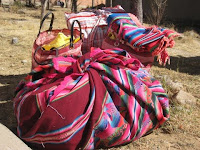Pillage and profit, from the Amazon to Ardoch: An evening of film, music, and discussion about the exploitation of Indigenous peoples' lands by Canadian companies
Monday April 23, 2012, 5:30 to 7:30 pm
Auditorium of the Ottawa Public Library, Main Branch
120 Metcalfe St. (at Laurier)
Ottawa, unceded Algonquin Territory
Join us for an evening of discussion with Indigenous peoples resisting the plunder of their lands by Canadian oil and mining companies.
Coffee, tea and some snack will be provided.
The event will be opened with a Blessing by Algonquin Elder Albert Dumont. There will be a screening of the award-winning documentary “Chumpi & the Waterfall”. This film explores the way of life of an Achuar community in the Peruvian Amazon – a way of life that's under threat by Canadian oil company Talisman Energy's plans to drill oil in their hunting and fishing grounds.
"I have told the CEO of Talisman, John Manzoni, that the Achuar people do not want oil operations in our ancestral territory, but Talisman refuses to respect our right to live in peace and harmony," says Achuar leader Peas Peas Ayui.
The film will be followed by a panel discussion with:
- Peas Peas Ayui, Lucas Irar Miik, Lucas Chayat Ayui, and Puwaanch Kintui Antich, leaders from Achuar communities in the Amazon rainforest
- Gregor MacLennan, Peru Program Coordinator for Amazon Watch
- Mireille Lapointe, former chief of the Ardoch Algonquin, who have resisted uranium mining on their land
- Marcelo Saavedra-Vargas, of the Quechua-Aymara nation and professor of Aboriginal studies at the University of Ottawa
Musical performances by Three Little Birds (https://www.facebook.com/
Admission is free; donations to support the Achuar community will be gratefully accepted.
This event is hosted by Amazon Watch, Indigenous Peoples Solidarity Movement Ottawa, and the Indigenous and Canadian Studies Students Association of the University of Ottawa.
Can't make it to the event? Please visit https://
- learn more about the Achuar
- Sign a petition demanding that Talisman Energy halt oil exploration in Achuar territory
- Donate to support the Achuar's cause
http://www.facebook.com/events/210214175756207/



